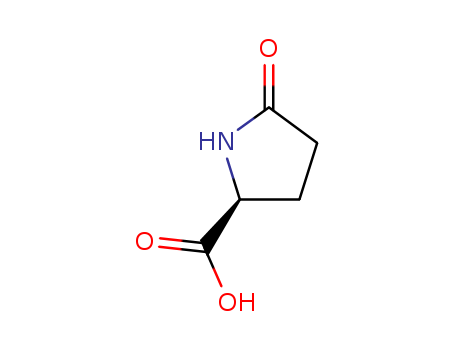Your Location:Home >Products >Biochemical Engineering >98-79-3


Product Details
|
Characteristics and Application |
L-pyroglutamic acid is an amino acid that occurs naturally in the body. It is present in the brain, spinal fluid, skin and blood.pyroglutamic acid is one of the major components of natural moisturizing factor of the skin, its moisturizing ability is far stronger than glycerin and propylene glycol. Moreover, it is non-toxic, non-irritating, and is an excellent raw material for modern skin care, and hair care cosmetics. Pyroglutamic acid also has inhibitory effect on the tyrosine oxidase activity, and thus preventing "melanoidins" substance from being deposited in the skin, and having a whitening effect on the skin. It has a keratin softening effect which can be used in nail cosmetics.In addition to be applied in cosmetics, L-pyroglutamic acid derivatives can also have reaction with a number of other organic compounds for synthesis of derivatives. It also has some special effect on the surface activity and brilliant effect. Moreover, it can also be used as surfactants for detergents; as a chemical reagent, it can be used for the resolution of racemic amines; it can also be used as a kind of organic intermediates. |
|
Pyroglutamic acid |
Pyroglutamic acid is a kind of based 5-oxo-proline. It is produced by the dehydration and formation of intramolecular amide bond between the α-NH2 group and γ-hydroxy of glutamic acid; the molecule can also be produced from glutamine by losing its intramolecular amine group. The condition of glutathione synthetase deficiency can cause the anemia of pyroglutamic acid with a series of clinical symptoms. Pyroglutamic acid anemia is a kind of organic acid metabolic disorder disease caused by glutathione synthetase hyperlipidemia. Clinical manifestations: disease onset occurs within 12 to 24 hours of born with progressive hemolysis, jaundice, chronic metabolic acidosis, mental retardation; urine containing pyroglutamic acid, lactic acid, α-deoxy-4-hydroxyphenyl acetyl acid lactone. For treatment, based on the actual symptoms, pay attention to adjust the diet after yearling. |
|
Chemical Properties |
It is colorless crystals with the melting point being 162-163 °C; it is soluble in water, alcohol, acetone and acetic acid, slightly soluble in ethyl acetate, but insoluble in ether. |
|
Uses |
L-pyroglutamic acid (PG) is used in the synthesis of:Nonproteinogenic amino acids such as (3S,4R)-3,4-dimethyl-L-pyroglutamic acid and (3S,4R)-3,4-dimethyl-L-glutamine. L-Pyroglutamic acid (L-PGA) is a cyclic amino acid in which carboxyl groups and keto oxygen atoms are linked. L-PGA is produced via intramolecular dehydration and cyclization of L-Glu. It is one of the most interesting cyclicals amino acid, which has been extensively studied and used in medicine and health, food, cosmetics, agriculture and other industries. |
|
Production method |
There are semi-synthetic methods, enzymatic conversion method and total synthesis method. Currently the major approach of industrial production is the semi-synthetic method with glutamic acid being the raw material. Have the 42% of glutamic acid solution heated at 140 °C for 3h to obtain the reaction solution with L-pyroglutamic acid being the major component. The reaction solution further undergoes concentration under reduced pressure, crystallization, washing, and drying to obtain the L-pyroglutamic acid with the conversion rate being 94%. |
|
Definition |
ChEBI: An optically active form of 5-oxoproline having L-configuration. |
InChI:InChI=1/C5H7NO3/c7-4-2-1-3(6-4)5(8)9/h3H,1-2H2,(H,6,7)(H,8,9)/p-1/t3-/m0/s1
This article explored a concise approach toward synthesizing a series of novel L-pyroglutamic acid analogues from L-hydroxyproline. Furthermore, bioassay studies of these sulfonyl …
Glutamine is one of the most abundant me...
Under heating conditions, L-Glutamic acid (L-Glu) can be dehydrated to form L-pyroglutamic acid (L-PGA), and L-PGA can racemize to form DL-PGA. Here, we characterized this …

L-glutamic acid γ-benzyl ester


benzaldehyde


benzoic acid


L-Pyroglutamic acid


benzyl alcohol
| Conditions | Yield |
|---|---|
|
With sodium hydroxide; sodium tetrachloropalladate(II); In water; Product distribution; Ambient temperature; initial pH:6.8; variation of initial pH and temperature;
|
37% 4% 24% |

L-glutamic acid 5-methyl ester


N,N-dimethyl-formamide


N-formylpyroglutamic acid


methyl (S)-pyroglutamate


L-Pyroglutamic acid
| Conditions | Yield |
|---|---|
|
With 3,5,5-Trimethylcyclohex-2-en-1-one; at 130 ℃; for 24h; Sealed tube;
|
21 %Chromat. |

D-Glutamic acid

L-glutamic acid

(S)-2-Amino-pentanedioic acid 5-ethyl ester

diethyl 2-aminopentanedioate

methyl (S)-pyroglutamate

L-(+)-1,1'-methylenebis[5-oxo-2-pyrrolidinecarboxylic acid]

N-(γ-glutamyl)methylamine

L-glutamic acid
CAS:56-12-2
CAS:7531-52-4
CAS:47375-34-8
CAS:84793-07-7